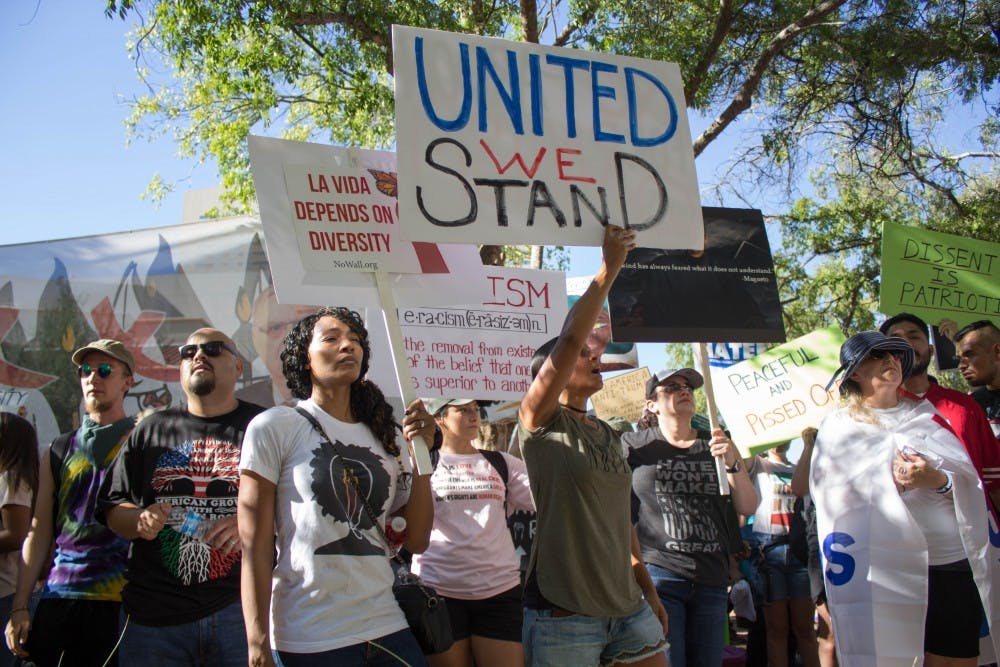A specter of violence haunts the current climate of U.S. politics. If it is not a Dodge Challenger running down protesters in the streets, it is a gunman scoping congressmen on a baseball diamond. When it is not open brawling in Sacramento, it is a mob running down a photographer fleeing for his life.
Discourse is beginning to give way to discord, and it seems that not a single political demonstration can pass without incident.
Peaceful protesting is something to be encouraged, but with recent police reactions to protesting, this does not seem feasible.
Now more than ever, the political sphere needs ambassadors who will demonstrate the proper rules of engagement when protesting or counter-protesting.
The recent protest in Phoenix, a few blocks shy of the ASU Downtown Phoenix campus, was similarly ill-fated.
"What happened that night was, without question, an act of terror on the part of the Phoenix police," said Fallon Leyba, junior creative writing major and chair of ASU's Students for a Democratic Society, when describing what transpired Tuesday, Aug. 22 at the Phoenix Convention Center.
The Students for a Democratic Society were among the many ASU students present at the rally and protest.
"Most of the group had left before the tear gas started," Leyba said. "The few that were left did not throw anything."
Thousands of protesters, students included, packed the streets adjacent to the Phoenix Convention Center.
While emotions ran high on both sides, the protest carried on peacefully throughout the day. But as the sun set, the event erupted into chaos.
Police equipped with body armor, shields and gas masks deployed tear gas, pepper balls and flash-bang grenades to disperse the gathering.
"I was right where they started firing," Leyba said. "I didn't catch the exact time, but it was unprovoked. They gave no warning before they started firing onto an entirely peaceful crowd."
In an interview with the Arizona Republic, Phoenix Police Chief Jeri Williams said the police took action due to a fight within the crowd. She also said rocks, water bottles and gas canisters had been thrown at the police line.
Police released a compilation of video clips that reveal what caused the situation to spiral out of control.
"We could have had a riot," Williams said. "We didn't have a riot because we were professional, we were dedicated, we were concise and we were very calculated in our approach."
Williams commends her officers for their show of restraint, and I also commend the thousands of spirited individuals who arrived to express their dissatisfaction, doing so within the bounds of the law.
During the civil rights movement, the day was won not by throwing punches or smashing objects, but by earning the sympathy of the populace through the struggle to be heard.
Needless to say, the day's end was unfortunate.
The peaceful protesters on one side of the street paid for the actions of a few individuals causing problems on the other. With police acting as one, the move to suppress a remote disturbance became an operation to shut down the entire demonstration, with thousands of people finding themselves gassed for seemingly no reason.
Yet, and I'm rather dismayed to say this, the event actually ended better than most political demonstrations in recent times. At least nobody, including ASU's own students, ended up concussed, shot, bloodied or dead.
The Phoenix Police Department will not be undergoing an independent review of its response at the protest. Nevertheless, hopefully more refined measures will be implemented so that police moving in to quell a rout don't have to involve peaceful protesters.
While there are certainly important questions to be asked about the police's use of force in this scenario, it really speaks to the times when protesters only being teargassed can be considered comparatively good news.
Of course, I would have preferred if everyone were able to act in a peaceful manner, but if it had to end on a sour note, I'd rather it be with mist in people's eyes than their blood on the streets.
Reach the reporter at jlbrook8@asu.edu and follow @jlbrook8 on Twitter.
Like The State Press on Facebook and follow @statepress on Twitter.
Editor’s note: The opinions presented in this column are the author’s and do not imply any endorsement from The State Press or its editors.
Want to join the conversation? Send an email to opiniondesk.statepress@gmail.com. Keep letters under 500 words and be sure to include your university affiliation. Anonymity will not be granted.




